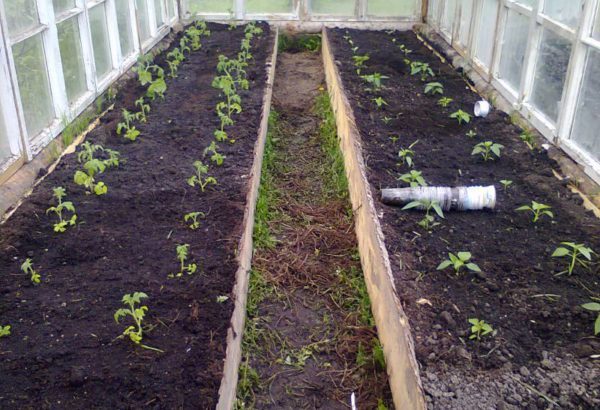Growing tomato crops in this region is accompanied by certain difficulties. Tomatoes are best cultivated in protected ground, because the harsh climatic conditions can be a hindrance to their normal development. But even in these conditions, it is possible to obtain quite good yields, if we strictly follow all the tips developed for the area. When to plant tomatoes in a greenhouse in Siberia later in our article.
Table of contents
Terms for planting tomatoes in a greenhouse in Siberia
If the greenhouse does not have heating and is not intended for growing crops all year round, then planting tomatoes using a seedless method, directly from the seeds, will not work even in the middle regions of Russia. And what about the northern territories, Siberia? A short summer for full cultivation will simply not be enough. So with the onset of spring, you should purchase seeds and all the preparations necessary to plant the seedlings.
For the period of growth of seedlings spikes twice. The first transplant is performed at the stage of the second - third leaf, the shoots are transferred into cups of ten-centimeter diameter. The second picking is done in two weeks, and the tanks are two to five centimeters in diameter more.
After the second dive, seedlings begin to harden, preparing to plant in a greenhouse or open ground. To this end, in warm weather, it is put on the street or on the loggia, windows are opened to teach the seedlings to lower temperature conditions and exposure to sunlight.
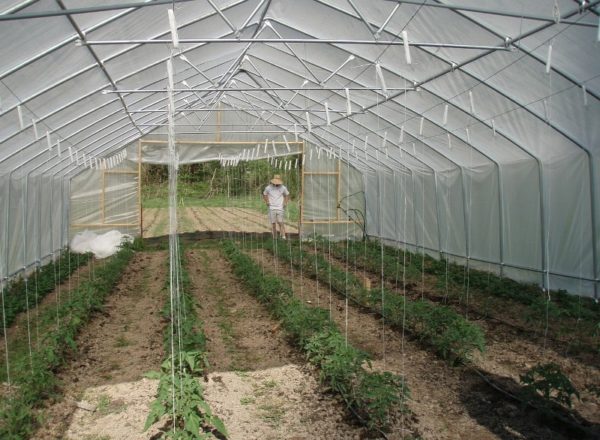
When the seedlings will be fifty days from the beginning of growth, and the height of the bushes will reach thirty to forty centimeters, the plants must be fully prepared for transplanting in a greenhouse. They are even kept for several days inside without a transplant, making it possible to get used to the microclimate better.
There is no exact date of transplantation - it all depends on your greenhouse. If there is heating, then it is quite possible to transplant plants in the extreme days of April.
In greenhouses made of polycarbonate or double film, seedlings are moved in late spring. But for greenhouses it is best to transfer plants in the twentieth of May.
These terms are considered approximate, since the final decision is taken by each gardener individually, taking into account the objective indicators:
- The soil composition should warm to a minimum of thirteen degrees Celsius;
- air temperature should not fall below twenty degrees.
Do not forget about local features. If the climate is mild in the area, then transplanting, even in a greenhouse without heating, is carried out in mid-May.
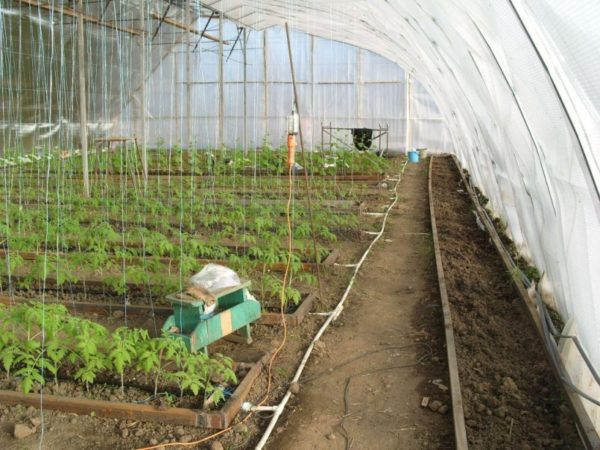
Is it possible to plant a bitter pepper next
Quite often, it is not possible to build several greenhouses, and I really want to diversify my table with vegetables. In such situations it is recommended to consider growing a number of several types of crops. Especially those who get along perfectly.
One such example is tomatoes and peppers. Both cultures belong to the Solanaceae, with close proximity give good yields. But it is necessary to take into account that the methods of planting and caring for tomatoes and hot or bitter pepper are slightly different.
In such greenhouses the focus is on the arrangement of the beds. Seeds for seedlings of peppers and tomatoes should be netted in late February - early March. In this case, the plants are planted in a chess sequence. First, high bushes of tomatoes are placed, then peppers are seated between them.
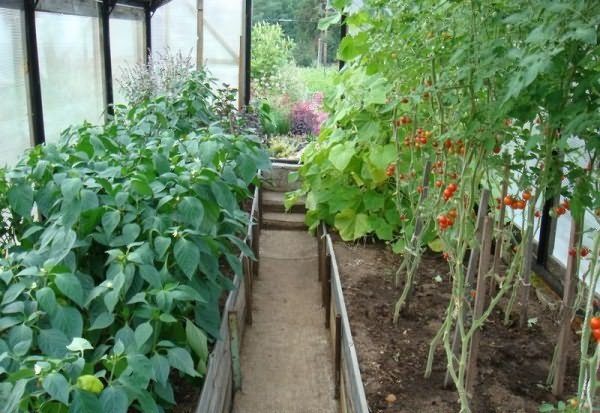
When you step up the tomato bushes, the peppers will get the necessary amount of air and light. Yes, and such a planting procedure will allow UV penetrate to each plant.
Pepper bushes can be planted along tomato beds. The culture will be protected from aphids by the smell of tomato plants.. The next option is the placement of crops: on the one hand there are tomatoes, on the other - peppers.
The best neighbors of tomatoes in the greenhouse (greenhouse)
Growing vegetables in the greenhouse, take into account their demands on the temperature and humidity.
Onion has an excellent compatibility with tomatoes, as it does not differ in particular demands on conditions. You can plant early cabbage varieties that ripen quickly and will not interfere with tomato bushes.
The next solution is to place strawberry beds together with tomatoes in order to feast on ripe berries in the spring. But in this case, the varieties of tomatoes should be nickled, so as not to strongly shade the berry bushes.
Some try to sow corn, but it must be located on the north side so as not to block sunlight for the tomatoes.
And this table shows tomato compatibility and bad neighborhood:
| Vegetables | Good neighborhood | Bad neighborhood |
| Asparagus | Tomatoes | Not |
| Beans | Corn, celery, savory, cucumbers, radishes, strawberries | Onion and garlic |
| Beet | Cabbage, broccoli, lettuce, onion, garlic | Beans |
| White cabbage, broccoli, Brussels sprouts | Beets, chard, potatoes, celery, dill, lettuce, onions, spinach | beans |
| Carrot | Legumes, Tomatoes | Not |
| Celery | Beans, Tomatoes, Cabbage | Not |
| Corn | Cucumbers, watermelons, pumpkin, peas, beans, pumpkin | Tomatoes |
| Cucumbers | Beans, Corn, Peas, Cabbage | Not |
| Eggplant | Beans, Peppers | Not |
| Melon | Corn, pumpkin, radish, zucchini | Not |
| Bow | Beet, carrot, chard, lettuce, pepper | Legumes |
| Peas | Beans, cucumbers, turnips, carrots, corn, radishes. | Onion garlic |
| Potatoes | Beans, Corn, Peas | Tomatoes |
| Zucchini | Corn, melon, pumpkin | Not |
| Tomatoes | Carrots, celery, cucumbers, onions, peppers | Corn, Kohlrabi, Potatoes |
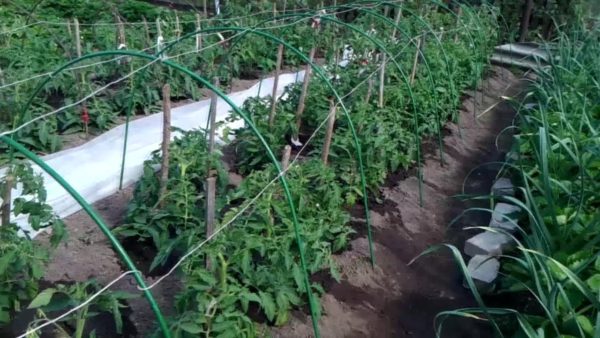
What crops can not be planted in the ground with tomatoes
Cucumbers could get along nicely near tomatoes in greenhouse conditions, but they differ in their requirements for temperature and humidity levels.And if there is only one greenhouse, then it is recommended to separate it with plastic wrap or some kind of non-woven material.
Tomato bushes do not like broccoli, cauliflower, eggplants to be placed near them, as these crops have common pests. The neighborhood with fennel and dill is considered undesirable if these greens are not planned for early harvesting.
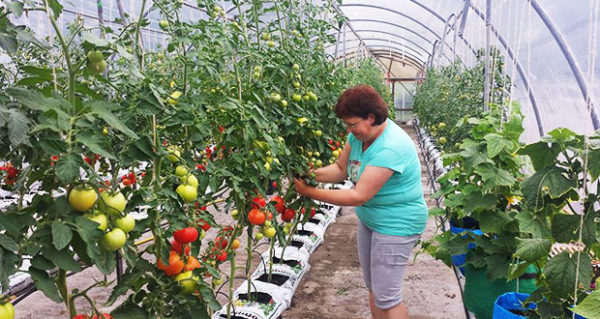
An excellent solution is to plant radishes, onions in a greenhouse, salads in a greenhouse. When the turn of tomatoes comes - the place for them will be freed.
Any gardener has his own secrets for growing vegetable plants. Do not be afraid to experiment, you can always find the best combination for your area. After all, a small plantation planted with various crops will provide you with everything you need for the winter season.
